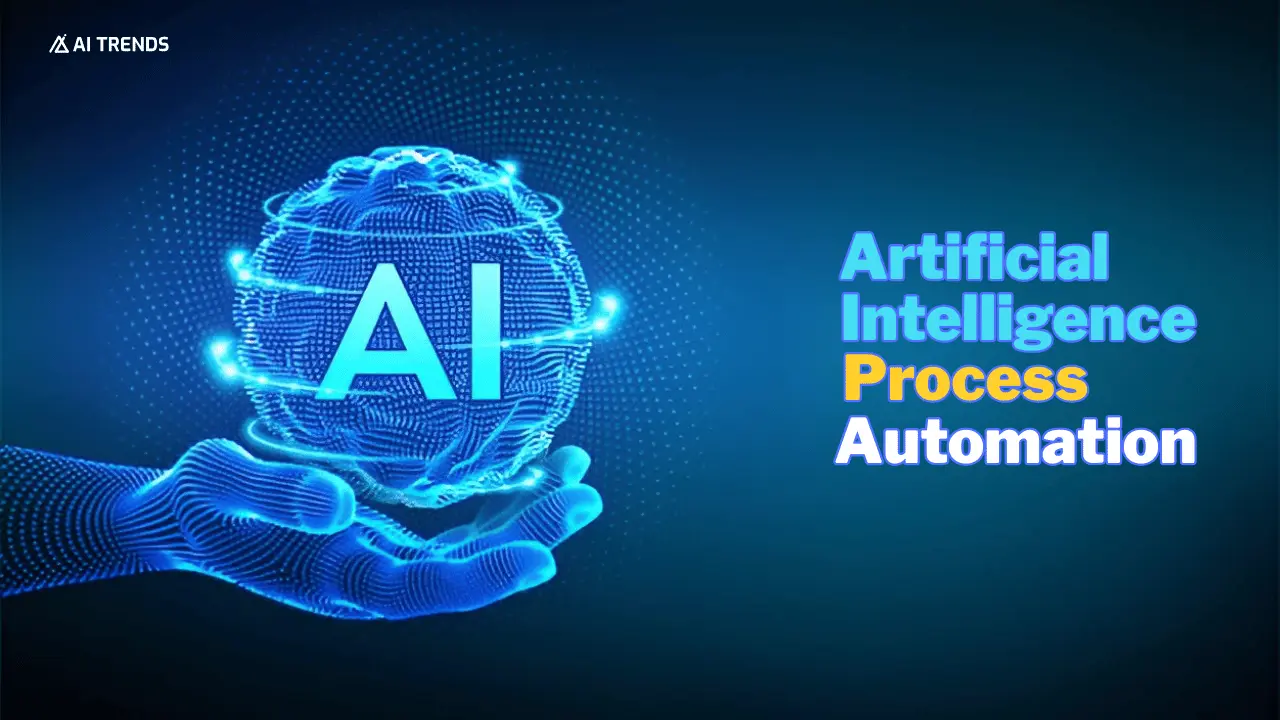One busy weekday morning, I noticed a teammate struggling with invoice processing for hours—painstakingly cross-checking purchase orders, confirming approvals, and typing data across different systems. Later in the day, it became clear that a single AI-powered automation tool could have finished the entire workflow in less than 15 minutes. That moment was eye-opening: we’ve truly stepped into a time where artificial intelligence performs repetitive business tasks with unmatched speed and accuracy.
The landscape of business operations is transforming rapidly. According to Gartner, 80% of executives believe automation can be applied to any business decision, while Forrester research indicates that 89% of developers have spent development time on low-code automation platforms in the past year. AI process automation is the backbone of modern business efficiency.
This comprehensive guide explores how intelligent automation revolutionizes workflows, reduces costs, and drives competitive advantage across industries. Whether you’re evaluating intelligent automation solutions or seeking to understand AI business process automation, you’ll discover actionable insights backed by expert analysis and real-world case studies.
Table of Contents
Understanding AI Process Automation: Beyond Traditional Methods
AI process automation represents the evolution of business process management, combining artificial intelligence with traditional automation to create intelligent automation platforms that learn, adapt, and optimize over time. Unlike simple robotic process automation (RPA), AI-powered systems can handle unstructured data, make complex decisions, and continuously improve performance.
The key differentiator lies in cognitive capabilities. Traditional automation follows pre-programmed rules, while intelligent process automation leverages machine learning, natural language processing, and computer vision to understand context and make intelligent decisions.
Core Components of AI Process Automation:
- Machine learning algorithms for pattern recognition and prediction
- Natural language processing for document understanding and communication
- Computer vision for image and video analysis
- Robotic process automation for task execution
- Process mining for workflow optimization
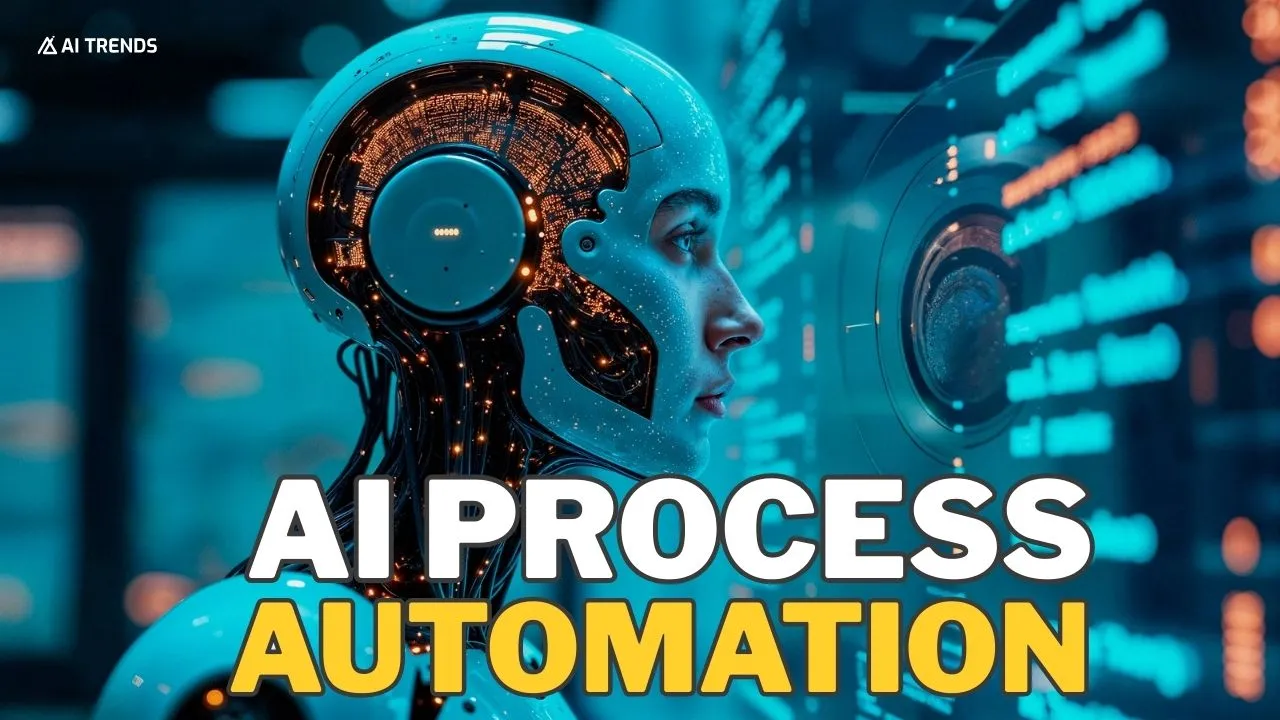
According to MIT Technology Review, organizations implementing cognitive automation report 25-40% reduction in processing time and 60% fewer errors compared to manual processes.
“The convergence of AI with process automation creates unprecedented opportunities for businesses to reimagine their operations,” explains Dr. Michael Chen, Chief Technology Officer at Enterprise Automation Institute. “We’re seeing companies achieve ROI within 6-12 months by deploying intelligent automation strategically.”
Key Benefits Driving AI Business Automation Adoption
The surge in AI business automation adoption stems from measurable benefits that directly impact bottom-line results. Organizations report significant improvements across multiple operational metrics when implementing intelligent automation tools.
Operational Efficiency Gains:
- 50-80% reduction in manual processing time
- 90% decrease in human error rates
- 24/7 processing capability without breaks
- Scalability during peak demand periods
- Consistent quality regardless of volume
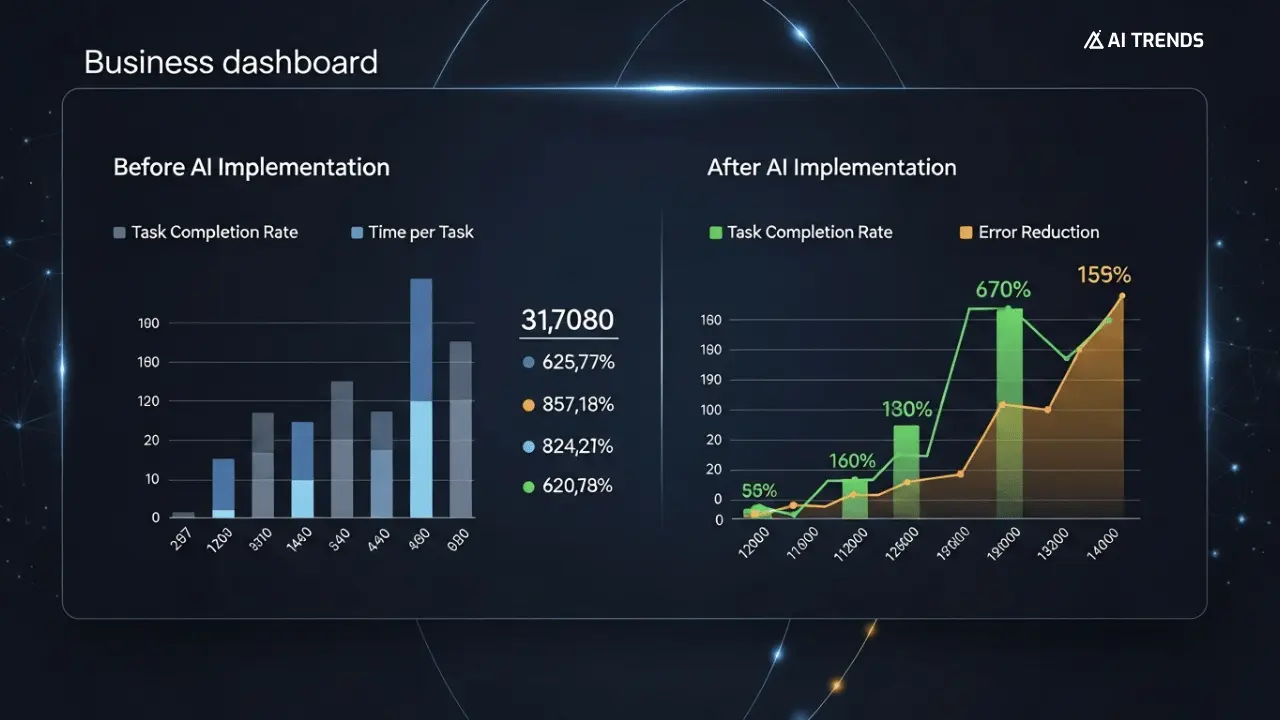
Cost optimization represents another compelling driver. Research from Stanford HAI demonstrates that enterprise automation initiatives typically reduce operational costs by 20-35% within the first year. The savings compound over time as AI systems learn and optimize processes continuously.
“We implemented AI process automation across our accounts payable department and saw immediate results,” shares Jennifer Rodriguez, Operations Director at TechFlow Solutions. “Processing time dropped from 4 days to 4 hours, while accuracy improved from 92% to 99.7%.”
Customer experience improvements also drive adoption. AI powered business efficiency enables faster response times, personalized service, and consistent quality that enhances customer satisfaction scores by an average of 23%, according to recent Forrester analysis.
The competitive advantage becomes evident when considering that early adopters often capture market share while competitors struggle with manual processes and longer cycle times.
Essential Intelligent Automation Solutions for Modern Businesses
Today’s intelligent automation platform landscape offers diverse solutions tailored to specific business needs and industry requirements. Understanding the categories and capabilities helps organizations select appropriate intelligent automation tools for their objectives.
Document Processing Automation:
- Invoice processing and accounts payable workflows
- Contract analysis and compliance checking
- Customer onboarding and KYC verification
- Insurance claims processing and underwriting
- Legal document review and summarization
Customer Service Automation:
- Chatbots and virtual assistants for first-line support
- Sentiment analysis for service quality monitoring
- Automated ticket routing and prioritization
- Knowledge base management and updates
- Multi-channel communication orchestration
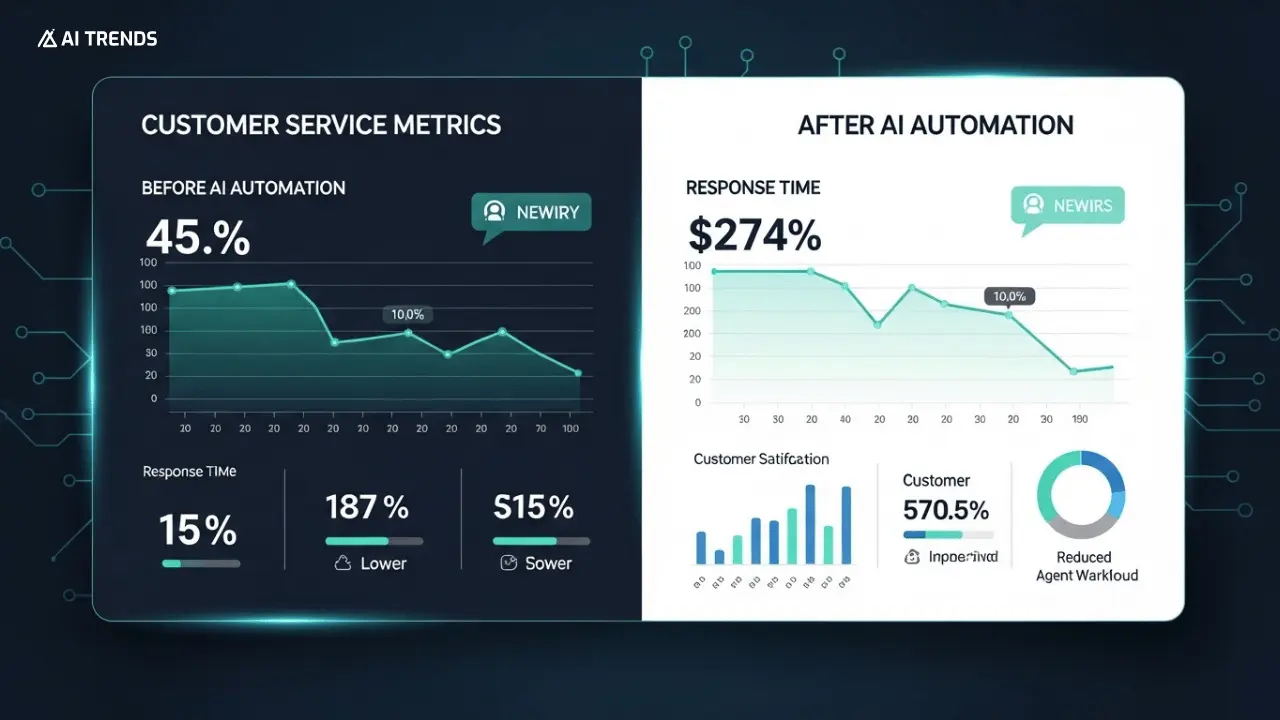
Financial Operations Automation:
- Fraud detection and risk assessment
- Regulatory reporting and compliance monitoring
- Credit scoring and loan processing
- Financial forecasting and budget analysis
- Treasury management and cash flow optimization
Supply Chain and Logistics Automation:
- Demand forecasting and inventory optimization
- Supplier performance monitoring and evaluation
- Quality control and defect detection
- Route optimization and delivery scheduling
- Procurement and vendor management
The integration capabilities of modern business automation tools enable seamless workflows across departments and systems. Organizations report 40% faster implementation times when choosing platforms with robust API connectivity and pre-built integrations.
Leading platforms also offer low-code development environments, allowing business users to create and modify automation workflows without extensive technical expertise. This democratization of automation accelerates adoption and reduces dependence on IT resources.
Real-World AI Automation Examples Across Industries
Examining successful AI automation implementations provides valuable insights into practical applications and expected outcomes. These examples of AI process automation demonstrate measurable impact across diverse business scenarios.
Healthcare Sector Transformation: Mount Sinai Health System implemented intelligent automation for medical records processing, reducing documentation time by 65% and improving physician satisfaction scores by 28%. The AI system automatically extracts relevant information from clinical notes, populates required fields, and flags potential coding errors.
Financial Services Innovation: JPMorgan Chase’s COIN (Contract Intelligence) platform processes legal documents that previously required 360,000 hours of lawyer time annually. The AI business process automation solution completes this work in seconds with 95% accuracy, freeing legal teams for higher-value advisory work.
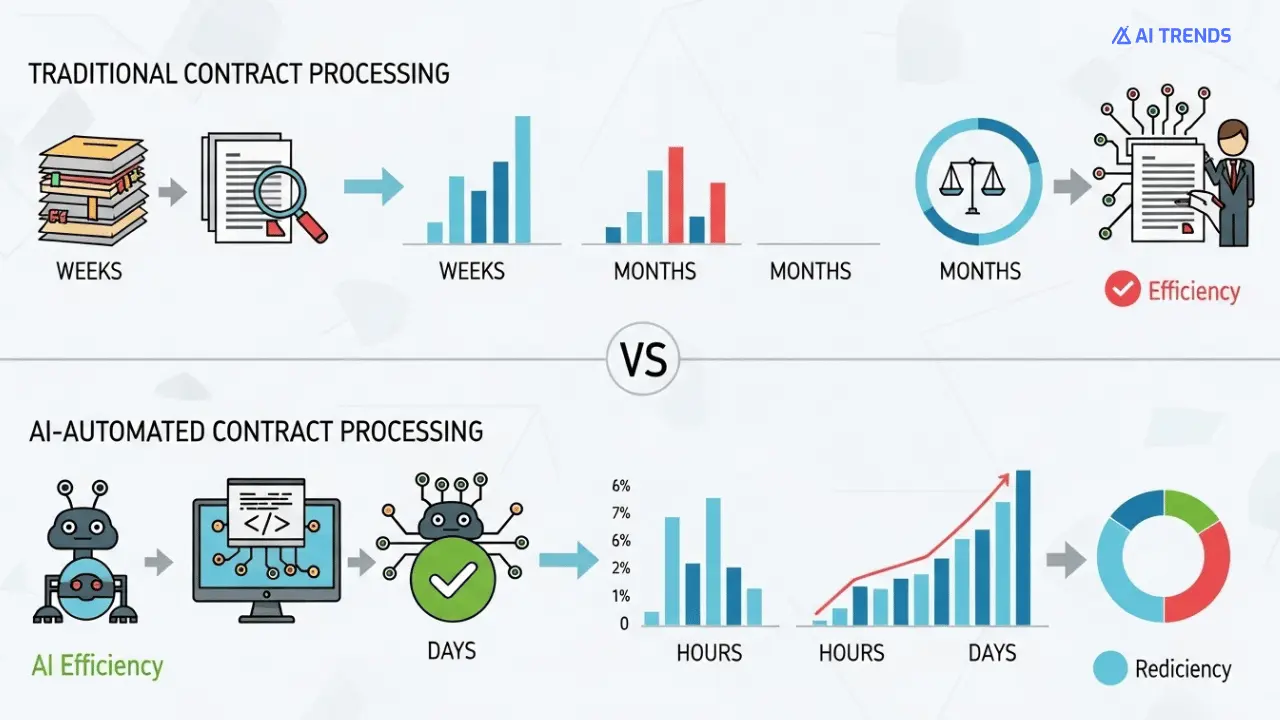
Manufacturing Excellence: Siemens deployed cognitive automation across quality control processes, achieving 99.99% defect detection accuracy while reducing inspection time by 75%. The AI system analyzes product images, identifies anomalies, and automatically adjusts manufacturing parameters to prevent defects.
Retail Operations Optimization: Amazon’s workflow automation handles millions of inventory decisions daily, optimizing stock levels across global warehouses. The system predicts demand, automatically reorders products, and adjusts pricing in real-time, contributing to a 20% improvement in inventory turnover.
Insurance Claims Processing: Lemonade Insurance processes simple claims in under 3 seconds using AI process automation. The system analyzes claim details, cross-references policy terms, detects fraud patterns, and approves payments automatically for straightforward cases.
These implementations share common success factors: clear process definition, quality training data, stakeholder buy-in, and phased deployment strategies. Organizations typically see initial benefits within 30-90 days of deployment.
Overcoming Implementation Challenges in Process Optimization with AI
Successful process optimization with AI requires addressing common implementation challenges that can derail automation initiatives. Understanding these obstacles and proven mitigation strategies ensures smoother deployment and faster value realization.
Data Quality and Integration Challenges: The foundation of effective AI automation relies on high-quality, accessible data. Many organizations discover their data exists in silos, lacks standardization, or contains errors that compromise AI performance.
Solution strategies include:
- Data auditing and cleansing before automation deployment
- Establishing data governance frameworks and quality standards
- Implementing master data management (MDM) systems
- Creating automated data validation and monitoring processes
- Training teams on data quality importance and best practices
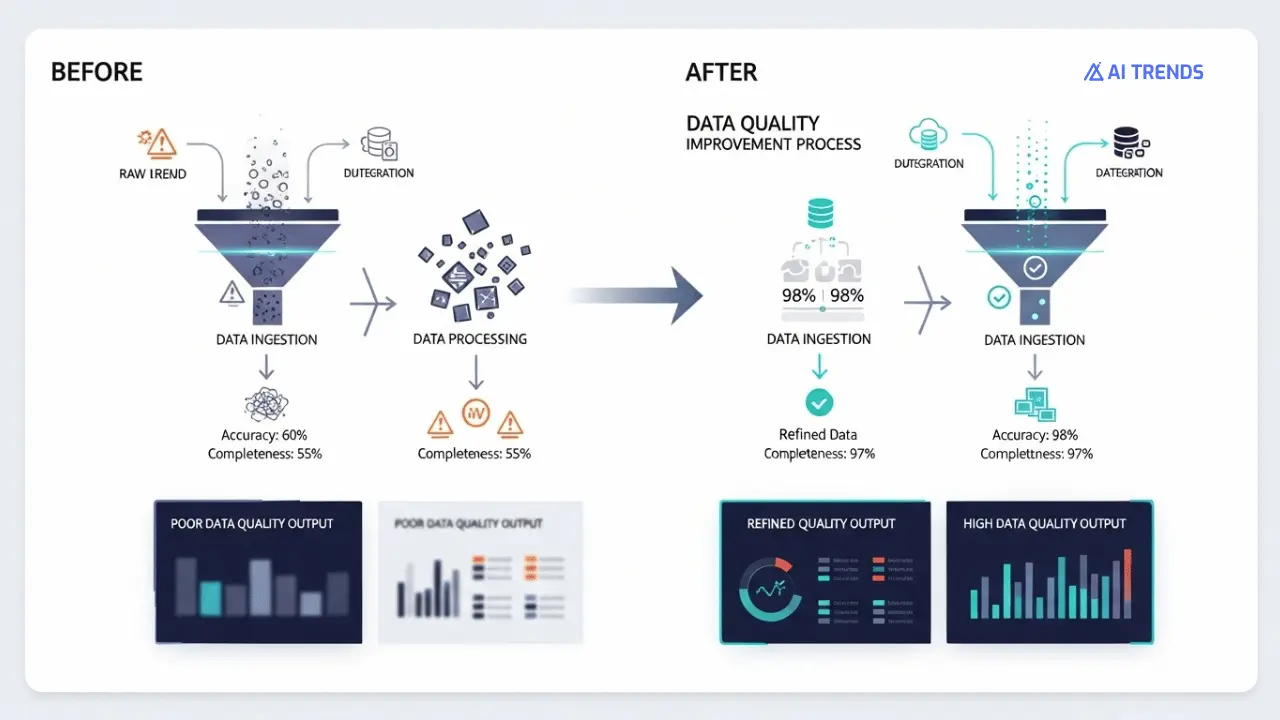
Change Management and User Adoption: Employee resistance represents a significant barrier to smart process automation success. Fear of job displacement, comfort with existing processes, and lack of technical skills contribute to adoption challenges.
“The human element is often underestimated in automation projects,” notes Sarah Martinez, Digital Transformation Consultant at Process Excellence Partners. “We’ve found that organizations investing in comprehensive change management see 3x higher adoption rates and 2x faster ROI achievement.”
Effective change management approaches:
- Transparent communication about automation benefits and job impact
- Comprehensive training programs for new tools and processes
- Involving end-users in design and testing phases
- Recognizing and rewarding early adopters
- Providing ongoing support and feedback channels
Technical Integration Complexity: Legacy systems often lack APIs or modern integration capabilities, making digital process automation deployment challenging. Security concerns and compliance requirements add additional complexity layers.
Integration best practices:
- Conducting thorough technical assessments before platform selection
- Choosing solutions with robust integration capabilities
- Implementing gradual migration strategies rather than big-bang approaches
- Establishing security and compliance frameworks upfront
- Creating detailed testing and validation procedures
Organizations following structured implementation methodologies report 60% higher success rates compared to ad-hoc approaches.
Future Trends Shaping AI Business Process Automation
The future of AI in business process automation promises even more sophisticated capabilities as technology advances and adoption accelerates. Understanding emerging trends helps organizations prepare for next-generation automation opportunities.
Agentic AI and Autonomous Workflows: Gartner predicts that autonomous AI agents will handle complex, multi-step processes independently by 2027. These intelligent automation solutions will plan actions, adapt to unexpected situations, and coordinate with other AI agents to complete business objectives.
Current developments include:
- AI agents that negotiate contracts automatically
- Autonomous financial trading and investment systems
- Self-managing supply chain orchestration platforms
- Independent customer relationship management workflows
- Automated compliance monitoring and reporting systems
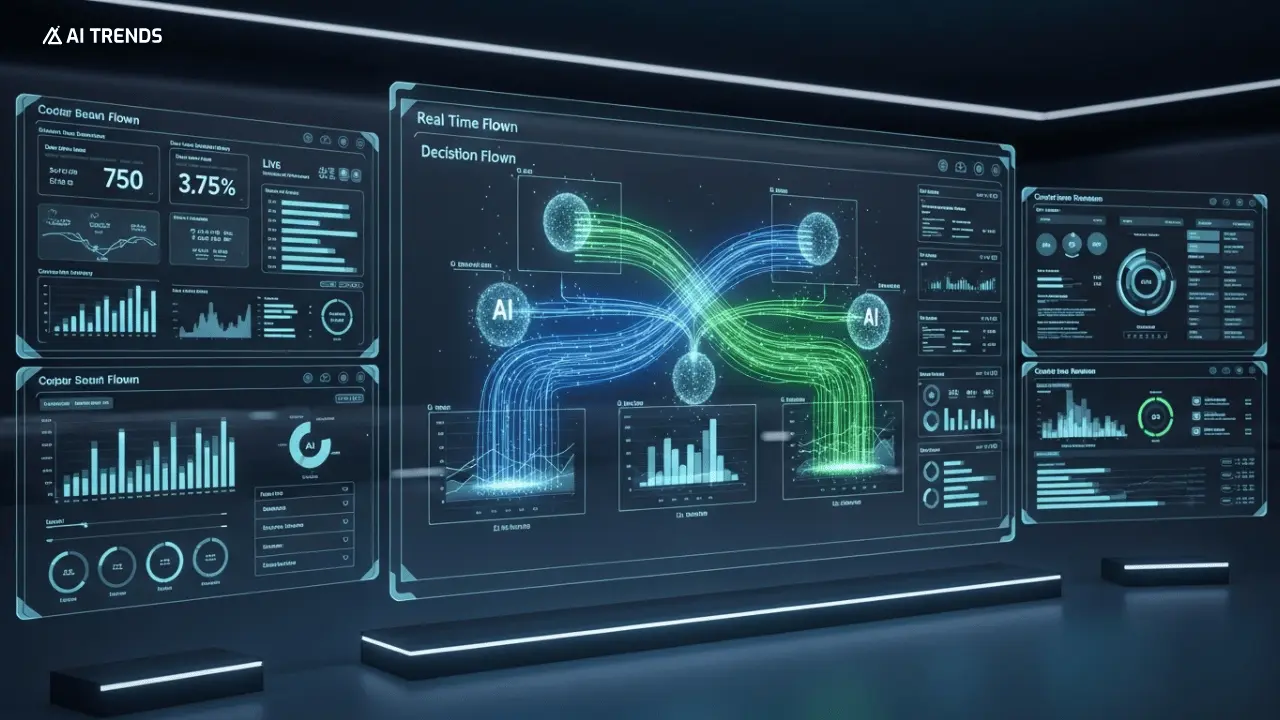
Hyperautomation and End-to-End Integration: The evolution toward hyperautomation involves connecting AI business automation across entire value chains rather than isolated processes. Organizations will deploy intelligent automation platforms that orchestrate complex workflows spanning multiple departments and external partners.
Key hyperautomation characteristics:
- Seamless integration between different automation technologies
- Real-time process optimization based on performance data
- Automatic discovery and automation of new process opportunities
- Cross-functional workflow coordination and management
- Continuous learning and improvement capabilities
Conversational AI and Natural Language Interfaces: Future intelligent automation tools will feature natural language interfaces that allow business users to create and modify automation workflows through simple conversation. This democratization will accelerate adoption and reduce technical barriers.
No-Code/Low-Code Evolution: The trend toward citizen development will continue, with business users creating sophisticated automation solutions without programming knowledge. These platforms will feature AI assistants that guide users through automation design and optimization.
Industry analysts project that best AI automation tools will incorporate predictive capabilities, automatically suggesting process improvements and identifying optimization opportunities before problems occur.
Selecting the Best AI Automation Tools for Your Organization
Choosing appropriate intelligent automation solutions requires careful evaluation of business needs, technical requirements, and organizational readiness. The expanding marketplace offers numerous options, making selection both critical and challenging.
Evaluation Framework for AI Automation Platforms:
Functional Requirements Assessment:
- Process complexity and volume requirements
- Integration needs with existing systems
- Scalability and performance expectations
- Security and compliance requirements
- User interface and experience preferences
Technical Capabilities Evaluation:
- AI and machine learning sophistication levels
- Data processing and analytics capabilities
- API connectivity and integration options
- Cloud deployment and hybrid support
- Mobile accessibility and remote work enablement
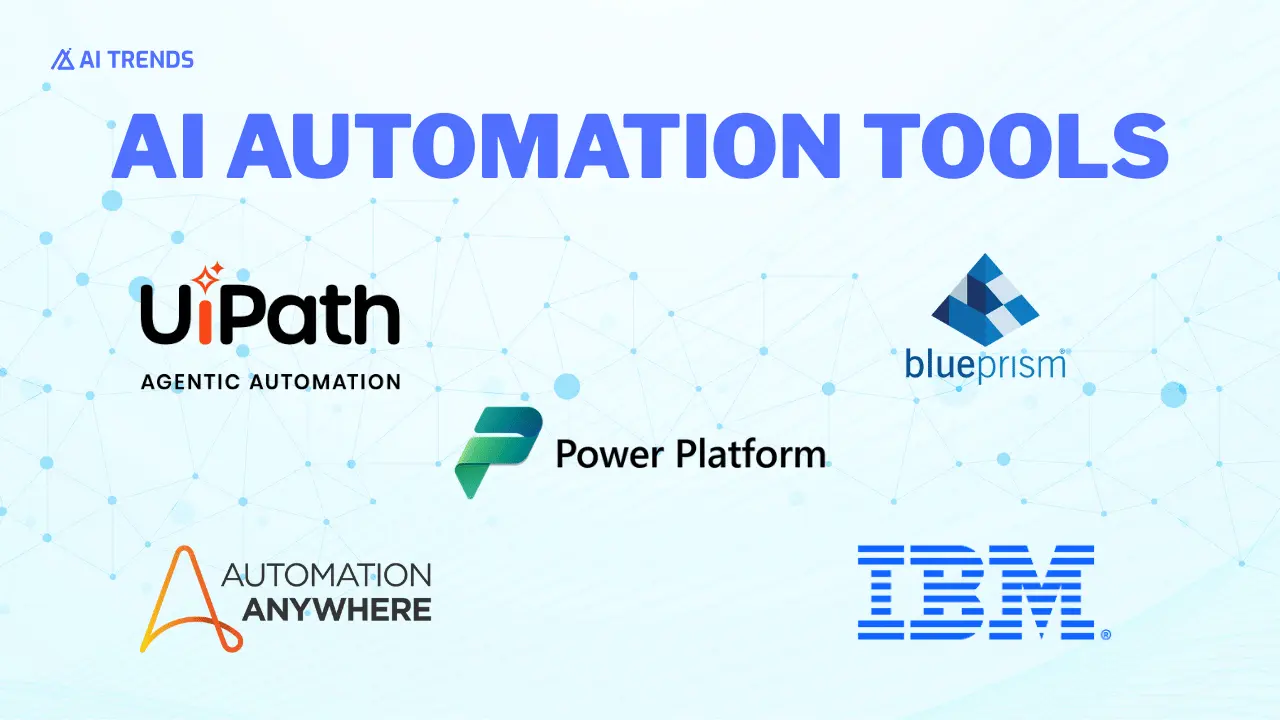
Leading Platform Categories:
Enterprise-Grade Solutions:
- UiPath: Comprehensive RPA with AI capabilities and process mining
- Automation Anywhere: Cloud-native platform with cognitive automation features
- Blue Prism: Enterprise-focused with strong governance and security
- Microsoft Power Platform: Integrated suite with Office 365 connectivity
- IBM Automation: AI-powered platform with industry-specific solutions
Mid-Market Solutions:
- Zapier: User-friendly workflow automation with extensive app integrations
- Monday.com: Project management with built-in automation capabilities
- Nintex: Document-centric automation with workflow optimization
- ProcessMaker: Open-source platform with customization flexibility
- Appian: Low-code development with intelligent automation features
Specialized Tools:
- Rossum: AI-powered document processing and data extraction
- DataSnipper: Excel-based automation for financial and audit processes
- Mindbridge: AI-enhanced financial analysis and risk detection
- Luminance: Legal document review and contract analysis
- Darktrace: Cybersecurity automation with AI threat detection
“The key is matching platform capabilities to specific use cases rather than choosing based on brand recognition,” advises David Park, Principal Analyst at Automation Research Group. “Organizations should prioritize solutions that integrate well with existing technology stacks and support long-term scalability goals.”
Implementation Timeline Considerations:
- Pilot project deployment: 4-8 weeks
- Department-wide rollout: 3-6 months
- Enterprise-wide implementation: 6-18 months
- Full optimization and maturity: 12-24 months
Return on investment typically becomes visible within 6-12 months for well-planned implementations, with continued benefits accumulating over time.
Measuring Success and ROI in AI Process Automation
Establishing clear metrics and measurement frameworks ensures AI process automation initiatives deliver expected value and justify continued investment. Successful organizations track both quantitative metrics and qualitative improvements.
Key Performance Indicators (KPIs):
Operational Efficiency Metrics:
- Processing time reduction percentages
- Error rate improvements and quality scores
- Throughput volume increases and capacity utilization
- Employee productivity and satisfaction improvements
- System uptime and reliability measurements
Financial Impact Measurements:
- Cost savings from reduced manual processing
- Revenue increases from faster customer service
- Compliance cost reductions and risk mitigation
- Capital expenditure optimization through automation
- Total cost of ownership (TCO) comparisons
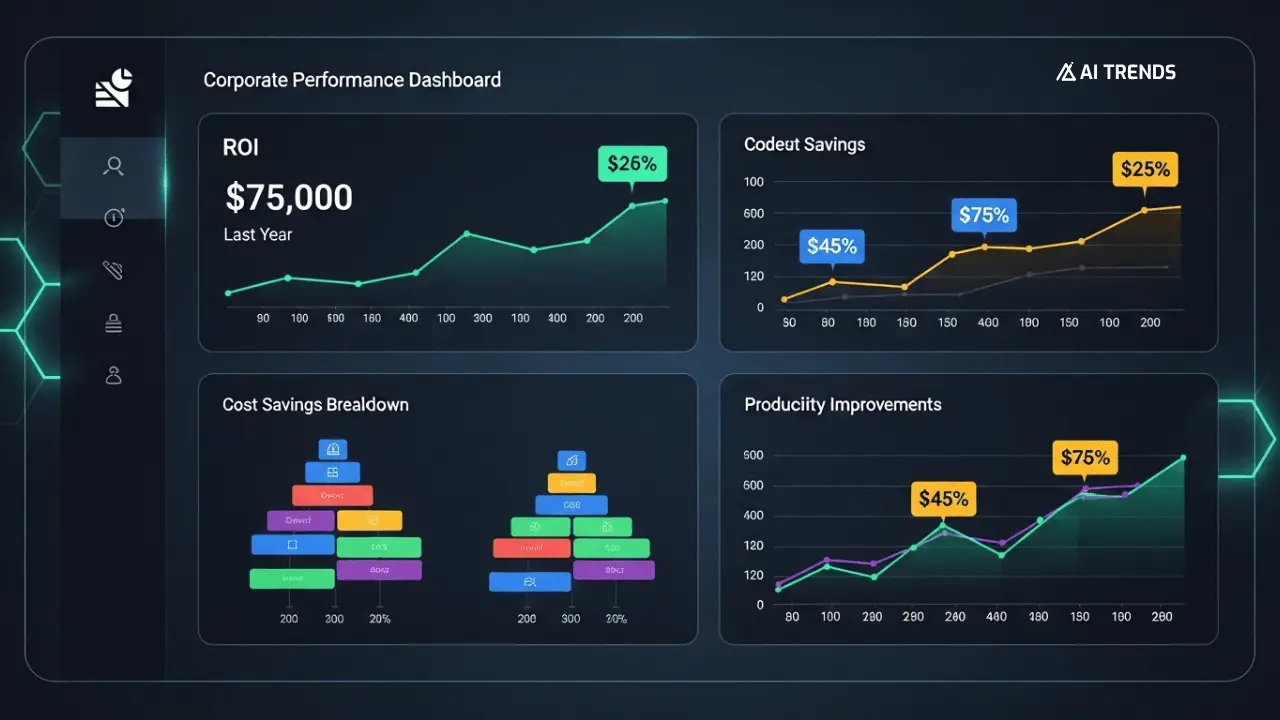
Customer Experience Improvements:
- Response time reductions and service level achievements
- Customer satisfaction scores and Net Promoter Scores (NPS)
- First-call resolution rates and service quality metrics
- Customer retention and loyalty measurements
- Digital experience ratings and feedback scores
Advanced Analytics and Continuous Improvement:
Modern intelligent automation platforms provide built-in analytics capabilities that track performance metrics automatically. Organizations should establish regular review cycles to assess progress and identify optimization opportunities.
Best practices for measurement:
- Baseline measurements before automation deployment
- Regular monitoring and reporting cadences
- Benchmarking against industry standards
- Continuous improvement processes and feedback loops
- Strategic alignment reviews and goal adjustments
“Measuring automation success goes beyond cost savings,” explains Patricia Thompson, Head of Digital Operations at Global Financial Services. “We track employee satisfaction, customer experience improvements, and strategic capability development to understand the full impact of our AI investments.”
Organizations typically see 15-30% additional improvements in the second year as AI systems learn and optimize processes based on historical data and changing business conditions.
Conclusion: Embracing the AI Process Automation Revolution
AI process automation represents more than technological advancement—it’s a fundamental shift toward intelligent, adaptive business operations that drive competitive advantage and sustainable growth. Organizations implementing intelligent automation solutions strategically position themselves for success in an increasingly digital economy.
The evidence is compelling: companies deploying AI business automation report significant improvements in efficiency, accuracy, and customer satisfaction while reducing operational costs by 20-40%. As artificial intelligence capabilities continue advancing, the gap between automated and manual processes will only widen, making early adoption increasingly critical for long-term competitiveness.
Success requires thoughtful planning, appropriate tool selection, and comprehensive change management. Organizations should start with clear use cases, invest in quality data foundations, and prioritize user adoption alongside technical implementation. The journey toward intelligent process automation may be complex, but the destination—streamlined, intelligent operations that adapt and improve continuously—justifies the investment.
Ready to explore how Generative AI vs Traditional AI can enhance your automation strategy? Discover actionable insights for implementing smart process automation in your organization, and learn about Top AI for Smarter Content creation that complements your workflow optimization efforts.
The future belongs to organizations that harness AI’s power to reimagine their processes. The question isn’t whether to adopt AI process automation—it’s how quickly you can begin transforming your operations for tomorrow’s challenges.
Frequently Asked Questions About AI Process Automation
What is AI process automation and how does it differ from traditional automation?
AI process automation combines artificial intelligence capabilities with traditional workflow automation to create systems that can learn, adapt, and make decisions. Unlike traditional automation that follows pre-programmed rules, intelligent process automation uses machine learning, natural language processing, and cognitive capabilities to handle unstructured data and complex scenarios. This enables automation of previously impossible tasks like document understanding, sentiment analysis, and predictive decision-making.
How can intelligent automation solutions benefit small and medium businesses?
Intelligent automation solutions offer significant advantages for SMBs, including reduced operational costs, improved accuracy, and enhanced customer service capabilities. Cloud-based platforms provide enterprise-level functionality at affordable subscription rates, while low-code tools enable implementation without extensive technical resources. SMBs typically see faster ROI due to simpler processes and quicker deployment timelines, with cost savings of 20-40% common within the first year.
What are the best AI automation tools for beginners?
Beginner-friendly AI automation tools include Zapier for simple workflow automation, Microsoft Power Automate for Office 365 integration, and UiPath Community Edition for RPA learning. These platforms offer intuitive interfaces, extensive documentation, and community support. Start with simple processes like email automation or data synchronization before advancing to complex cognitive automation scenarios.
How do businesses measure ROI for AI business process automation projects?
AI business process automation ROI measurement involves tracking both cost savings and value creation metrics. Key measurements include processing time reduction, error rate improvements, labor cost savings, and customer satisfaction improvements. Organizations should establish baseline measurements before implementation, track metrics continuously, and consider both direct financial benefits and strategic value like improved compliance and competitive advantage.
What challenges should organizations expect when implementing intelligent automation platforms?
Common challenges include data quality issues, system integration complexity, user adoption resistance, and change management requirements. Technical challenges involve legacy system connectivity and security considerations. Organizations should plan for 3-6 months implementation timelines, invest in comprehensive training, and establish clear governance frameworks. Successful implementations typically start with pilot projects and scale gradually across departments.





